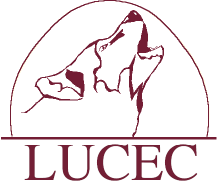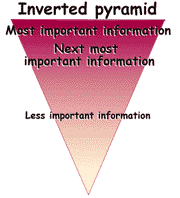

Covering the Environmental Beat
Saturday, Dec. 16, 2000Loyola University New Orleans, Room 329
Reporting Basics
ToolsThe first thing you need to be a reporter is a pad and a pen. You can't buy a real reporter's notebook at Walmart. We order them by the case, so we wanted you to have one so you can be prepared to take notes today. By this afternoon, you should have enough notes to write a story.
Research
The second thing you need to do is a little research on the topic you want to write about. You will get a chance to do some research in the library and on the Internet later today.
Developing Sources/Conducting Interviews
The third thing you need to do is develop sources and conduct interviews. In journalism, and especially environmental reporting, the sources for your stories are very important. Sources can be documents of all kinds, press releases, government reports, etc.
But when we talk about developing sources we are usually talking about meeting and getting to know people who will talk to you "on the record" for a story. You might find yourself talking to a scientist, for example, like Dr. Bob Thomas here. He is a biologist, and if you ask him the right questions, he can tell you a lot about the science of how wetlands are important in the Louisiana environment.
You might also talk to politicians, or other non-elected officials who work for the government, maybe someone at the Corps of Engineers or the Louisiana Department of Environmental Quality. An easy way to find out how to contact those departments would be to use a search engine like Google.
When you conduct an interview, all that means is you are asking people questions. But you need to be courteous and diplomatic, and approch your subject objectively. That means leaving your personal opinions and biases behind and trying to get "just the facts." With many sources, you need to come prepared for the interview, which means you need to do a little research and know some basics about your topic.
Then ask yourself these six essential questions: Who, What, When, Where, How and Why, the five W's and the H. These are the basic questions to answer for any story.
For example, check out this story I did recently for the Dallas Morning News on the recent oil spill in the Mississippi River. See if you can find these 6 elements.
Taking Notes
During an interview, even if you have a tape recorder, you need to take notes. This is one of the hardest things cub reporters have to learn. It seems simple, but even my reporting students in university classes have some trouble becoming proficient at this. You take notes in classes all the time. But you need to be fast AND accurate, because you are going to put into print what people say for the world to read. Believe me, they will get very mad if you misquote them, or if you get their name wrong.
What's the first thing you should ask when beginning an interview? Ask them to spell their name, even if it is John Smith. Some people spell it Jon Smythe.
So be fast, but be careful to write down exactly what people say if you plan to quote them accurately, even if you have to ask them to repeat the information. And get their name right. That's really rule No. 1.
Deciding What's News/News Values
Once you have enough information for a story, it's time to sit down and write. How do you decide what to write? What's important? That's one of the hardest things to decide, especially on a complicated environmental story.
But in journalism education, we have some values to guide us. Some of them are:
- Timeliness: Did the event just happen? Old news is no news.
- Proximity: Where did it happen? The closer the more newsworthy.
- Prominence: Are the people involved rich and powerful?
- Unusual: Is the information bizarre or out of the ordinary?
- Impact: Who will be affected and how much?
- Conflict: Are there people on both sides of the issue who disagree? How heated is the fight?

Writing Styles
Once you decide what the news is, what's important, there are thousands of ways to approach the writing of a story. But we will talk about two here today: the inverted pyramid style and the narrative style.The inverted pyramid style calls for the writer to decide the order of importance of the facts. The most important fact is reported first, followed by the next important fact, and so on. Stories usually start with a one-sentence lead of about 30 words or less. Notice the lead on the oil spill story we looked at earlier.
The narrative style of writing, however, does not necessarily begin with the most important fact first. The idea here is to draw people into the story with more of a feature lead. Notice the same oil spill story, done as a followup feature two days later.
But when a reporter is on deadline, like you are today, and time is limited, use the inverted pyramid and the news values to help guide you in your writing. And don't forget to answer the six essential questions.
Good luck today and in your future careers as environmental reporters. Any questions? You can always e-mail me at: gw@loyno.edu .